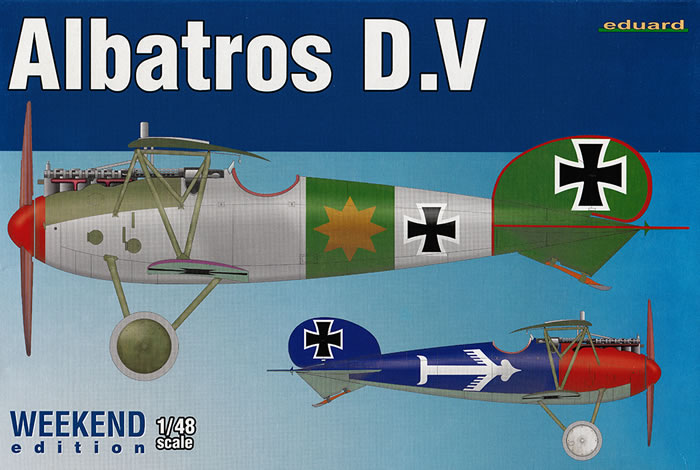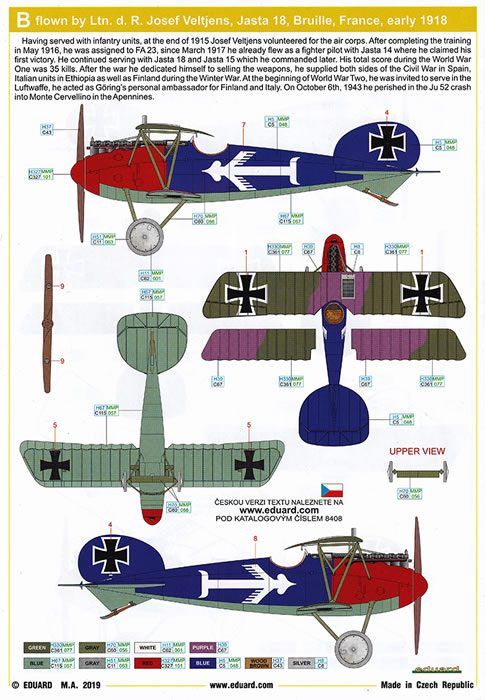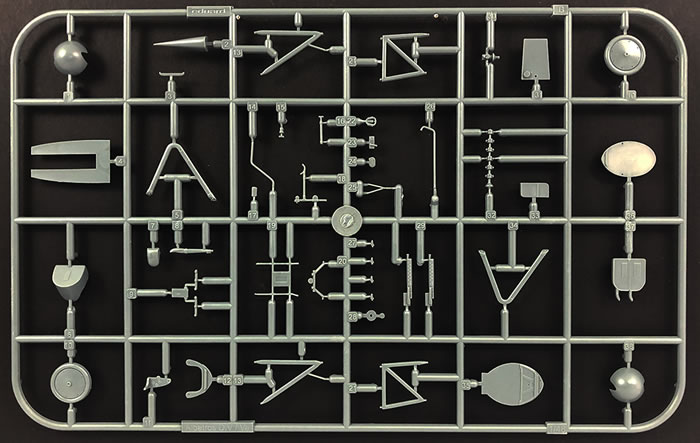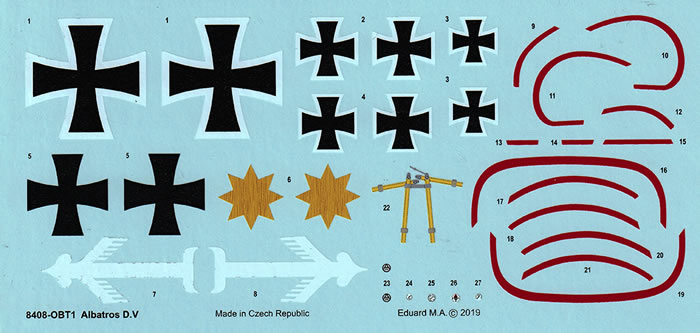Albatros D.V

Eduard Weekend Edition, 1/48 scale
S
u m m a r y |
| Catalogue Number and Price: |
Eduard Kit No. 8408 - Albatros D.V Weekend Edition
USD$24.95 plus shipping available online from Eduard
GBP£14.20 EU Price (£11.83 Export) plus shipping available online from Hannants
|
| Scale: |
1/48 |
| Contents and Media: |
2 grey injection moulded sprues containing 60 parts, 1 sheet of decals and an 8 page instruction booklet . |
| Review Type: |
FirstLook |
| Advantages: |
A kit with crisp yet subtle moulding with good level of detail, Eduard’s usual high quality instructions. It has 2 colourful schemes offered. |
| Disadvantages: |
Fairly complex rigging which will challenge many (myself included). |
| Conclusion: |
A chance to add a well detailed, yet fairly simple construction kit with colourful WWI German schemes. A nice kit! |
Reviewed by David Couche

The Albatros D.V was a fighter aircraft built by the Albatros Flugzeugwerke and used by the Luftstreitkräfte (Imperial German Air Service) during World War I. The D.V was the final development of the Albatros D.I family and the last Albatros fighter to see operational service. Despite its well-known shortcomings and general obsolescence, approximately 900 D.V and 1,612 D.Va aircraft were built before production halted in April 1918. The D.Va continued in operational service until the end of the war.
The D.V entered service in May 1917 and structural failures of the lower wing immediately occurred. In 2009, Guttman wrote that "Within the month Idflieg was doing belated stress testing and concluding, to its dismay, that the D.V’s sesquiplane wing layout was even more vulnerable than that of its predecessor".The outboard sections of the D.V upper wing also suffered failures, requiring additional wire bracing and the fuselage sometimes cracked during rough landings.
Against these problems, the D.V offered very little improvement in performance. Front line pilots were considerably dismayed and many preferred the older D.III; Manfred von Richthofen was critical of the new aircraft. In a July 1917 letter, he described the D.V as "so obsolete and so ridiculously inferior to the English that one can't do anything with this aircraft". British tests of a captured D.V revealed that the aircraft was slow to manoeuvre, heavy on the controls and tiring to fly.

Albatros responded with the D.Va, which featured stronger wing spars, heavier wing ribs and a reinforced fuselage. The modified D.Va was 23 kg (51 lb) heavier than the D.III but the structural problems were not entirely cured. Use of the high-compression 130 kW (180 hp) Mercedes D.IIIaü engine offset the increased weight of the D.Va. The D.Va also reverted to the D.III aileron cable linkage, running outwards through the lower wing, then upwards to the ailerons to provide a more positive control response. The wings of the D.III and D.Va were interchangeable. To further strengthen the wing, the D.Va added a small diagonal brace connecting the forward interplane strut to the leading edge of the lower wing; the brace was also retrofitted to some D.Vs.
Idflieg placed orders for 262 D.Va aircraft in August 1917, followed by orders for another 250 in September and 550 in October. Ostdeutsche Albatros Werke, which had been engaged in production of the D.III, received orders for 600 D.Va aircraft in October. Deliveries of the D.Va commenced in October 1917.

The structural problems of the Fokker Dr.I and the mediocre performance of the Pfalz D.III left the Luftstreitkräfte with no alternative to the D.Va until the Fokker D.VII entered service in mid-1918. Production of the D.Va ceased in April 1918. In May 1918, 131 D.V and 928 D.Va aircraft were in service on the Western Front; the numbers declined as the Fokker D.VII and other types replaced the Albatros in the final months of the war. By 31 August, fewer than 400 Albatros fighters of all types remained at the front but they continued in service until the Armistice.
Text mostly from Wikipedia
A sturdy Eduard box opens to 2 sprues of grey injected moulded, nicely detailed parts with only 60 parts on them which enables you build a very nicely detailed model quite simply.
There is an A6 sized sheet of decals and the usual comprehensive instruction booklet. All sprues are cleanly moulded with no flash evident, and have a mix of raised and recessed detail as is required. I believe this could be a real “weekend” kit without the rigging due to a small parts count and a simple, yet colourful pair of paint schemes. The rigging is given one diagram for what is a fairly complex rigging layout. Maybe a 3 way set of diagrams would offer clearer rigging positions, especially for rigged aircraft novices, like myself.
Sprue A
Sprue A is the airframe sprue for the Albatros D.V.

The sprue has 15 grey injected moulded parts of which 3 are not used, including a lovely pilot figure which I would think would paint up nicely to give the cockpit a point of interest and a propeller not used on these aircraft. Found here are the wonderfully detailed fuselages, rudder, tailplanes and a lovely pair of engine halves.
Sprue B
This sprue offers up 45 parts, 2 of which are not used, and which are the remaining parts of the aircraft. Parts here include the wheels, all the struts, cockpit parts, small engine parts and the guns.

All parts are cleanly moulded and have little to no flash or mould marks on the whole but the struts do have some minor flash.
Instructions and Decals
The instructions for the kit are the usual Eduard, with a glossy booklet of 8 A5 pages of high quality detailed instructions, with copious colour call outs throughout, using the Gunze Aqueous, Mr Color as well as the Mission Models range.

The decals are printed by Eduard and appear to be in perfect register giving the options for 2 different aircraft and they are:
-
Albatros D.V, flown by Vzfw. Richard Dilscher, Jasta 5, Boistrancourt, France, July 1917
-
Albatros D.V, flown by Ltn. D.R Josef Veltjens, Jasta 18, Bruille, France, early 1918
Eduard has again produced a nicely detailed, yet fairly simple kit of the Albatros D.V in their Weekend Edition range. Despite not having the bells and whistles resin, etch and masks, this kit will build into a very high quality model and certainly will bring some brightness to your model cabinet with the great colourful schemes. A highly recommended kit for the WWI modeller
Thanks to Eduard for the sample
Review Text Copyright © 2020 by David Couche
Page Created 4 March, 2020
Last updated
4 March, 2020
Back to HyperScale Main Page
Back to Reviews Page Woo! |
